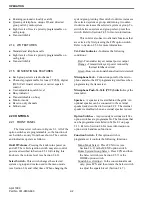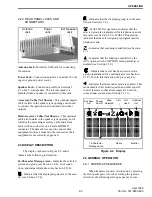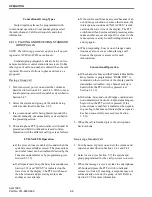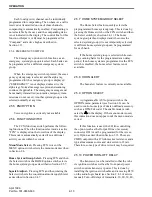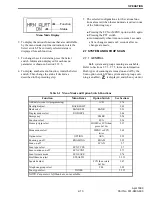
OPERATION
2-15
April 1999
Part No. 001-9800-600
2.7.4 LTR MODE SCANNING
With LTR mode scanning, the home repeater of
each LTR system in the scan list is scanned. Scanning
is sequential through all LTR systems in the scan list.
If several positions are programmed with the same
LTR system, system information is loaded only once.
Therefore, there is no delay to change systems which
results in very efficient scanning of those positions.
Each home repeater is scanned for only as long as
necessary to detect all calls. Priority calls are detected
on LTR systems while scanning (see Section 2.8.1).
LTR systems are not scanned if an LTR-Net system is
selected (see preceding section).
2.7.5 CONVENTIONAL MODE SCANNING
With conventional operation, the channels of each
conventional system in the scan list are scanned in
order. Call Guard squelch is detected if the monitor
mode is disabled (see Section 2.11.1). If the monitor
mode is enabled, all calls occurring on a scanned chan-
nel are received. Conventional systems are not
scanned if an LTR-Net system is selected (see Section
2.7.3).
A feature called Adaptive Tone Scan (ATS) is
used when scanning conventional channels. If no
carrier is detected, the channel is scanned for only 40
ms. If a carrier is detected, searching for Call Guard
signaling occurs (if programmed). If the tone type of
Call Guard squelch is programmed, the channel is
monitored for 180-420 ms. The shorter time is when
the tone is outside certain limits, and the longer time is
if it is at or near the programmed value. If digital type
is programmed, approximately 350 ms is required to
determine an invalid code (less time is usually
required to detect valid codes).
2.7.6 SCAN LIST PROGRAMMING
NOTES: Calls are always detected on the revert
(selected) system/group while scanning even if it is
deleted from the scan list.
Deleting LTR-Net systems from the scan list also
deletes them from locality searching when roaming
even when scanning is disabled (see Section 2.9.3).
The system and group scan lists are user
programmable using the A/D (add/delete) option
switch. If this switch is not programmed, scan list
programming is not available. The scan lists can be
programmed even if scanning is not enabled. The
displayed system is in the scan list and scanned
normally when
is displayed, and the displayed
group is in the scan list and scanned normally when
is displayed (see illustration on page 3-14).
The system/group select mode described in
Section 2.4.5 controls if the system or group scan list is
changed when the A/D switch is pressed. If this switch
is pressed with the system select mode enabled, the
status of the displayed system is changed. Likewise, if
it is pressed with the group select mode enabled, the
status of the group is changed. For example, to change
the status of the displayed system, press the Select
switch if necessary so that the system select mode is
indicated and then press the A/D switch.
Deleting a system only temporarily deletes the
groups associated with that system. When a system is
added back into the scan list, the original group scan
list is again active. Systems and groups can be deleted
from the scan list while listening to a message on the
system or group by pressing the A/D switch in the
normal manner. Scanning resumes shortly after the
system or group is deleted.
Saving Current Scan List Changes
The menu SCN SAVE parameter or the default
programming of this parameter determines if changes
to the system and group scan lists are saved. If “ON”
is selected, changes are saved to memory as they are
made and the scan list does not change when power is
cycled. If “OFF” is selected, changes are not saved
and the programmed default status is reselected when
power is cycled.
2.7.7 SCAN DELAY AND CONTINUE TIMERS
Receive Delay
When a message is received while scanning, there
is a programmable delay of 0-7 seconds before scan-
ning resumes. This delay is called the Receive Delay
Time, and it prevents another message from being
received before a response can be made. This delay is
also in effect if a control is changed while scanning
such as selecting another system/group. This timer is
reset each time another call is received.
Содержание 984X SERIES
Страница 2: ......
Страница 84: ...LTR NET OVERVIEW 4 10 April 1999 Part No 001 9800 600 7KLV SDJH LQWHQWLRQDOO OHIW EODQN...
Страница 85: ......
Страница 86: ...Part No 001 9800 600 4 99hph First Issue Printed in U S A...


